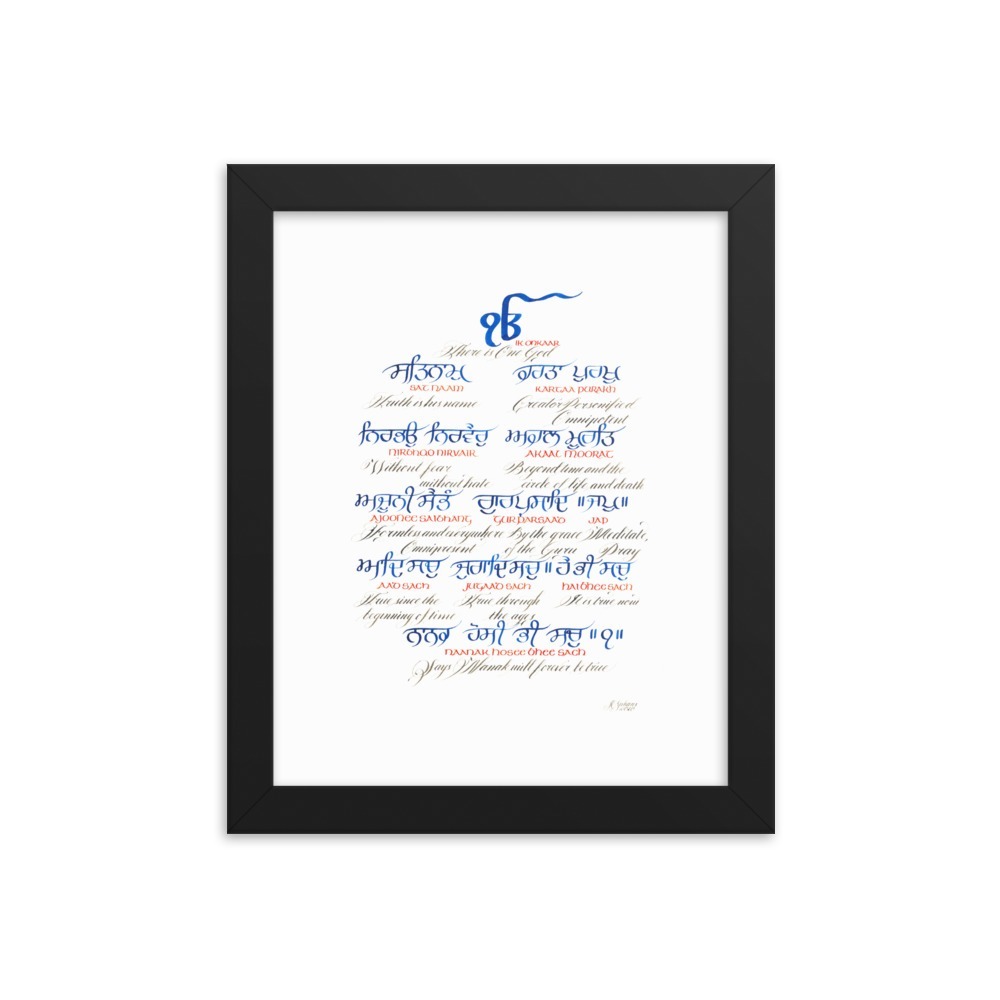Inscribing the Mool Mantar or Mul Mantar
When the COVID-19 restrictions came into place in March of 2020, like many other wedding services, I received phone calls, emails and notifications from customers cancelling their bookings.
Finding myself disheartened and despondent. I thought, well, this is the perfect time to tidy my scriptorium. Sort through the inks, paints, paper and nibs. Great, all done. It was wonderful to see the scriptorium looking so tidy.
But then I found myself sitting at my desk, looking blankly at my inks and nibs, wondering what am I to do now? Like a bolt from the sky, it struck me! There’s a heap of projects that I’ve had on the long finger. You know the ones. The ones that you will do when you have a moment. I have the time now, I thought to myself. As that thought entered my mind, I knew exactly what I was going to do.
A cousin once suggested that I inscribe the Mool Mantar or Mul Mantar which is a prayer that all Sikh youngsters are taught and although I was already familiar with it, I wanted to understand more before I began.
Mool is a term meaning primary, major, or root. Mantar also denotes a magic spell or concoction. The phrase “Mool Mantar” refers to the core chant or root verse. The Sikh ideology is encapsulated in this lovely prayer. The Mool Mantar is the foundation of Sikh philosophy. It is the opening prayer of the Sikh Holy Scriptures, known as the Guru Granth Sahib and was composed by Guru Nanak Dev Ji, the founder of Sikhism.
It is said
Guru Nanak Dev Ji composed the Mool Mantra after his journey of enlightenment. He was close to 30 years old. He had walked 28,000 kilometres, covering most of the Indian subcontinent and parts of the Middle East, before reaching his final destination in Punjab 24 years later. Whereupon, he established the three pillars of the Sikh faith. The Mool Mantar encapsulates Sikh philosophy and emphasises the equality of all people and the oneness of God.
With a better understanding of the meaning behind this powerful mantra, the journey and its importance. I took out my tools. And I embarked on my calligraphy journey and started to inscribe this beautiful prayer.
My desk was busy and untidy, just the way I like it, while I figured out the lettering, colours and layout. Part of the process was: do I inscribe this in one language or two? I knew that, like me, a few of my cousins and my siblings didn’t learn Gurbani as children. So, it made sense to use Gurbani, phonetic Gurbani and English. My cousin and I went through several translations until we finally found one that we believed was the best translation.
My first thought was to use one colour, black but as I worked out the layout, I realised that the colour was a necessity and the colours I chose were going to play into the meaning of this beautiful prayer.
Orange, reminiscent of the saffron of India, symbolises purity and spirituality, representing the connection between the dharmic indigenous belief systems.
Blue, the colour of Khalsa, embodies wisdom and stability, reflecting the strength and tranquillity of Sikhism.
Earth brown is the grounding of the composition; it signifies stability and connectedness to the earth, emphasising the rooted nature of the Mul Mantar. Each colour was carefully chosen to help weave a tapestry of meaning, infusing the Mul Mantar with a visual language to help deepen its spiritual resonance.
A few weeks later, once I was satisfied that the piece was finished and ready to show. I held my breath as I cautiously shared it with my family and asked, “Would anyone like a copy?” To my utter amazement and surprise, they loved it! I was in shock and bowled over. It took me a few days to settle myself before organising prints and posting them off.
To purchase your own 10″ x 10″ Framed Print
Here are some of the resources:
- https://www.sikhiwiki.org/index.php/Mool_Mantar
- https://dharmayudh.com/enlightenment-story-of-guru-nanak-dev-foundation-of-sikhism-life-story-first-guru-of-sikhism/
- https://trandexpress.com/viral-story/the-enlightenment-of-guru-nanak-and-a-glimpse-into-his-global-udasis/
- https://www.indiadivine.org/significance-and-meaning-of-saffron-color-in-hinduism/
- https://www.beautyofindia.in/saffron-color/
- https://slightlyblue.com/symbolism/blue-meaning-in-sikhism/

